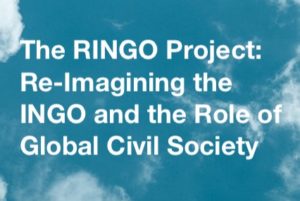Why thinking about long-term structures in a crisis is so hard, but also so vital.
Over the past weeks, I’ve been asked on a few occasions to postpone a meeting, say with a group of funders or an INGO, because of the war in Ukraine. Staff members are being drawn into meetings, and funds and resources are being rapidly diverted. The Guardian tragically reported how the conflict is taking much-needed resources away from other emergencies, with a blunt headline reading: “Take from the hungry to feed the starving.”
As RINGO is a project that’s not about the crisis, but is instead about the long-term structures of civil society, it’s not surprising that many in the international civil society sector simply cannot engage in our work. It’s not a crisis. It’s not an emergency. People aren’t dying from the immediate threat of not engaging with RINGO.
But there is also something deeper at play here. When I started working in International Development twenty-five years ago, my first role was working on an initiative hosted by the British Red Cross, to set up an International Ombudsman for Humanitarian Aid. It wasn’t long before I saw the very clear divide between those who relished the idea of ‘saving’ people in an emergency context, fueled by adrenalin, and clearly thrived in chaos…and those who completely withdrew, waiting for the storm to pass to resume their work of the long-term bread and butter of ‘development.’
And herein lies a dilemma: there are almost always crises and emergencies in this sector, even more so now as climate change bites. Our organizational cultures often prohibit ways and means to do the long-term work that’s necessary to redesign the system. This is why there have been multiple scandals happening over multiple years in the sector – since my time with the Ombudsman Project, most people often reflect that deep change is needed. And that’s regardless of which sector of the INGO system you’re in: humanitarian, development, peacebuilding, or environment.
So how do we do long-term change amidst the constant churn of crises?
In the run-up to the current conflict in Ukraine, RINGO was in the midst of nurturing a prototype that would explore the human rights relationships in the CEE region and had identified a Ukrainian organization who could potentially host this idea. The prototype, led by a RINGO Lab member based in Russia, was going to look at the relationship between local and international human rights actors, whilst identifying new roles and modes of solidarity at local, regional, and international levels. These weren’t just big existential questions – they were very real, very practical things to consider, from the dominance of the English language (which led to certain biases), to the flow of resources and the decision-making power.
Whilst CEE isn’t a ‘developing’ region in the same way as our north-south relationships in the RINGO Lab, the region still encounters the same dynamics of civil society relationships: ‘capacity building’ by educated, English speaking westerners; trickle-down resource flows, increasingly blocked by repressive states. And as a consequence? We have a weaker, local civil society system overall.
Needless to say, this prototype idea has been parked for now, but even amidst a crisis, the issues still remain. Watching the conflict from the other side of Europe, I can feel the relevance of our long-term systemic work in the RINGO Lab as it relates to the way in which the civil society response has been happening in Ukraine and neighboring countries.
The UK International Development Sector, through the Disaster Emergency Committee, raised circa £55 million in the first weekend of its appeal in early March. Whilst the fundraising effort and the generosity of the British public is to be applauded, there are, nonetheless, some concerns. Funding appeals from all the mainstream agencies are highlighting their links with local organizations and saying ‘we already have people on the ground’ in the region. This may come as a surprise as Ukraine isn’t a country where aid agencies traditionally work. Relationships with partners take time to nurture. And like so many emergencies that have come before, we reveal a different picture: the immediate, practical work of the myriad of local organizations supporting people on the front-line who know the local context, yet who continue to be bereft of funds and attention. Decisions continue to be made at the international rather than the local level, in a top-down, emergency-driven way.
There are lessons of solidarity already being learned that are encouraging to see. At the same time, what the INGO and local civil society sector needs to be doing now is planning for what is to come and put the systems in place, even in this emergency context. We can take the RINGO principles of co-design and collaboration to draw out the possible scenarios – short, medium and long-term – and do a hands-on design of what will be needed from each level of civil society in these scenarios and how we can resource it effectively. In the words of our Russian colleague:
“We are forced to be reactive, but can’t afford to be just reactive. Immediate reactions are, as a rule, based on already existing instruments and modes of thinking that have already failed us. It is very evident if we look at how traditional human rights instruments are pretty much obsolete in this emergency context and while human rights might be as relevant as ever, traditional human rights organizations are quite the opposite.”
Indeed, the Ukraine response can be a lab within the Lab – what can we learn in real-time and what can we do differently, with the knowledge we have already gleaned from the RINGO project about roles, power, collaboration, and resources? With a careful and genuinely collaborative approach, we have the ability to set the stage for a stronger civil society in the region, and at the same time strengthen the INGO’s role in relation to their needs.
Photo by Izzy Gibson on Unsplash

